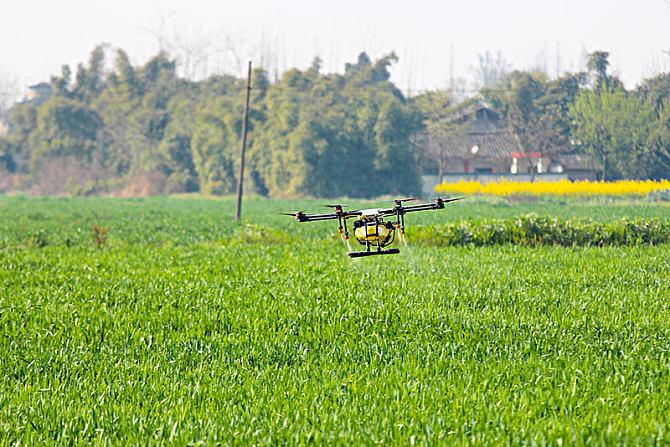Industrial drones, as an efficient and convenient auxiliary means, replace existing tools to serve daily work in various industries. They have advantages such as low cost, high efficiency, good maneuverability, and convenient use, and can ensure the safety of industry operations.
From the perspective of application structure, due to differences in starting time and development level, the market demand and application maturity of industrial drones vary in different application fields. At present, the market demand and application maturity of industrial drones in agricultural plant protection in China are very high, which not only benefits from the introduction and support of national agricultural policies, but also from the application of cutting-edge technologies in the industry.
RTK centimeter level positioning technology
RTK technology, also known as real-time carrier phase difference technology, is a new positioning method that can achieve high-precision differential positioning in the field. The data is safe and reliable, and can generally reach centimeter level accuracy within 10 kilometers of the base station. It is the most widely used GNSS differential technology.
The operating environment of plant protection drones is complex and diverse, and they generally rely on planned routes during the flight process, which has high requirements for control accuracy of flight status. If the accuracy of autonomous flight of plant protection drones is not well grasped, there may be repeated spraying of pesticides, missed spraying of pesticides, or uneven spraying in some areas, leading to a large-scale reduction in crop production and causing economic losses.
The application of RTK technology in agricultural plant protection machines can, on the one hand, reduce the restrictions on the takeoff and landing areas of drones, improve the accuracy of flight routes, achieve high-precision autonomous flight, and ensure that the spraying range of drones is more accurate. On the other hand, it can improve the efficiency of pesticide use and promote agricultural drones to truly embark on the path of precision operations.
Terrain following technology
Terrain following technology, also known as ground simulation flight, is an application of altitude determination technology, which determines the relative altitude. In order to ensure the uniform and efficient spraying of pesticides, the “terrain following” technology introduced by the plant protection drone can maintain a relative height of 1-2 meters with crops throughout the operation process, greatly improving the terrain adaptability of the plant protection drone operation.
Omnidirectional Digital Radar Technology
In unmanned aerial vehicle (UAV) plant protection operations, omnidirectional radar technology can identify horizontal and omnidirectional obstacles, and has automatic obstacle avoidance and ground simulation flight functions to achieve automatic detour at any position, fully ensuring work safety and providing 360 degree comprehensive safety protection. At the same time, the operation of omnidirectional digital radar is not affected by environmental light and dust, and can perceive the agricultural environment 24/7, further improving flight safety and ensuring efficient and orderly plant protection operations.
Centrifugal atomization spraying technology
Precision pesticide application is an important link in precision agriculture and a trend in the development of future plant protection drones. Centrifugal atomization spraying technology is a key technology for achieving precise spraying. The centrifugal atomization nozzle uses a rotating spraying mode to spray out drugs, and at the same time, it is pushed by the friction of the centrifugal disc to convert large droplets into small droplets during the spraying process, which is more detailed, ensuring uniform distribution of the drug and effective penetration into the plant surface, achieving contact killing and prevention effects, better saving pesticide costs, and reducing blockage problems during the drug spraying process, Provide efficient and precise protection for crops.
Obstacle avoidance technology
Obstacle avoidance technology is a guarantee for increasing the safe flight of drones. With the development and maturity of technology, it has been applied in practical applications in plant protection drones. The most common obstacle avoidance technologies for unmanned aerial vehicles are infrared sensor schemes, ultrasonic sensor schemes, laser sensor schemes, and visual sensor schemes. The application of obstacle avoidance technology in plant protection drones can automatically bypass obstacles, and can perform intelligent fault prediction and obstacle avoidance at night, ensuring the safety of drone operations at night and during the day, further improving the efficiency and safety of plant protection drones.
The times are changing, and the application and development of cutting-edge drone technology in the field of agricultural plant protection have effectively solved problems such as inaccurate sowing, time-consuming and laborious sowing, rising costs, and pesticide residue toxicity in agricultural applications. The continuous optimization and popularization of HANVO industrial grade avionics system products in the field of agricultural plant protection will help the industry better develop green, intelligent, and innovative agriculture.







Please sign in to comment
register